Is the Continued Use of Imprisonment as a Form of Punishment Justified?
VerifiedAdded on 2023/04/20
|10
|2956
|121
AI Summary
This article discusses the justification and impact of imprisonment as a form of punishment. It explores the trends in incarceration rates, the effectiveness of rehabilitation programs, and the communicative purpose of punishment. The article argues that while imprisonment can be a symbolically appropriate response to crime, it is important to improve the communicative models of imprisonment to achieve positive social goals.
Contribute Materials
Your contribution can guide someone’s learning journey. Share your
documents today.
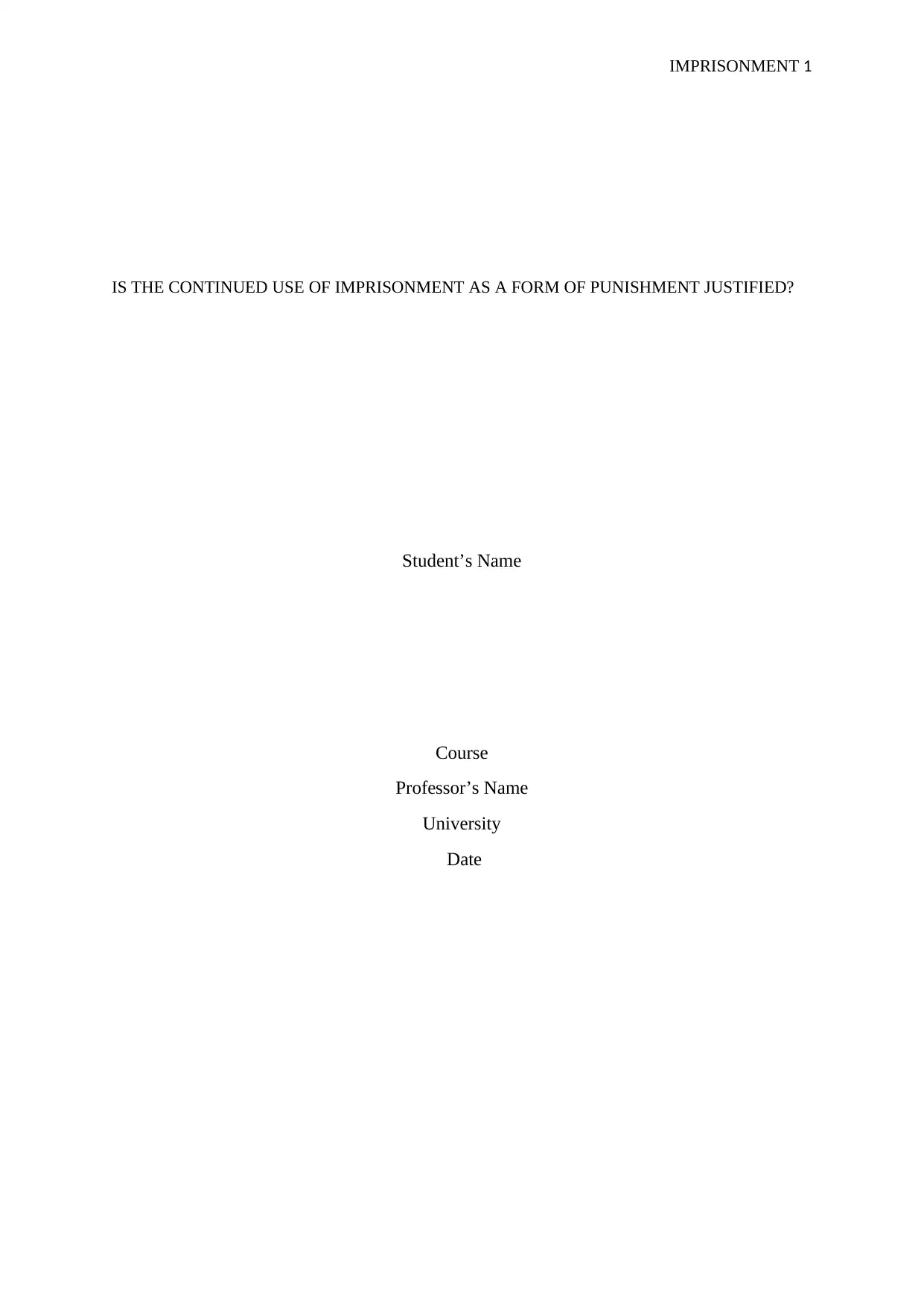
IMPRISONMENT 1
IS THE CONTINUED USE OF IMPRISONMENT AS A FORM OF PUNISHMENT JUSTIFIED?
Student’s Name
Course
Professor’s Name
University
Date
IS THE CONTINUED USE OF IMPRISONMENT AS A FORM OF PUNISHMENT JUSTIFIED?
Student’s Name
Course
Professor’s Name
University
Date
Secure Best Marks with AI Grader
Need help grading? Try our AI Grader for instant feedback on your assignments.
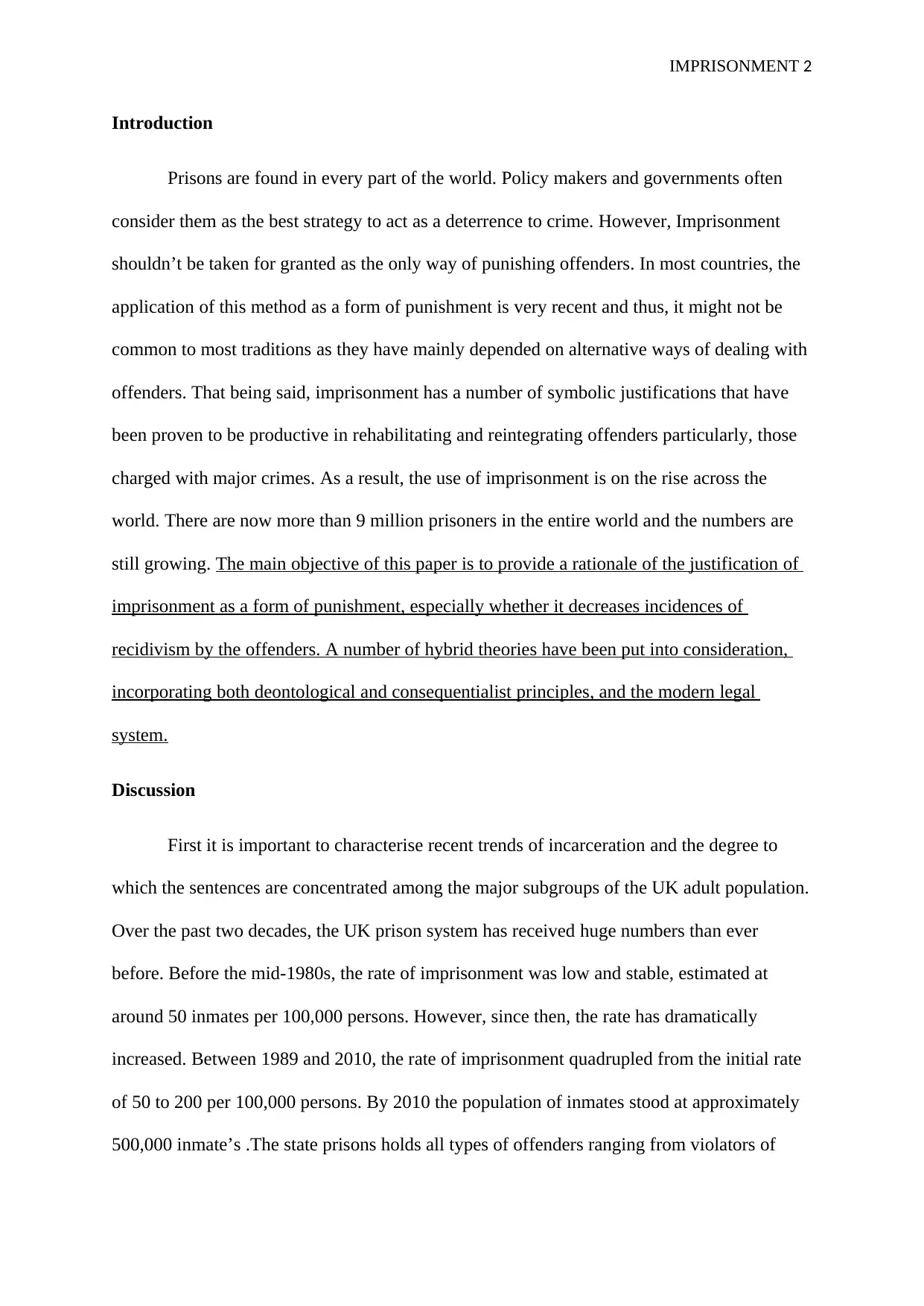
IMPRISONMENT 2
Introduction
Prisons are found in every part of the world. Policy makers and governments often
consider them as the best strategy to act as a deterrence to crime. However, Imprisonment
shouldn’t be taken for granted as the only way of punishing offenders. In most countries, the
application of this method as a form of punishment is very recent and thus, it might not be
common to most traditions as they have mainly depended on alternative ways of dealing with
offenders. That being said, imprisonment has a number of symbolic justifications that have
been proven to be productive in rehabilitating and reintegrating offenders particularly, those
charged with major crimes. As a result, the use of imprisonment is on the rise across the
world. There are now more than 9 million prisoners in the entire world and the numbers are
still growing. The main objective of this paper is to provide a rationale of the justification of
imprisonment as a form of punishment, especially whether it decreases incidences of
recidivism by the offenders. A number of hybrid theories have been put into consideration,
incorporating both deontological and consequentialist principles, and the modern legal
system.
Discussion
First it is important to characterise recent trends of incarceration and the degree to
which the sentences are concentrated among the major subgroups of the UK adult population.
Over the past two decades, the UK prison system has received huge numbers than ever
before. Before the mid-1980s, the rate of imprisonment was low and stable, estimated at
around 50 inmates per 100,000 persons. However, since then, the rate has dramatically
increased. Between 1989 and 2010, the rate of imprisonment quadrupled from the initial rate
of 50 to 200 per 100,000 persons. By 2010 the population of inmates stood at approximately
500,000 inmate’s .The state prisons holds all types of offenders ranging from violators of
Introduction
Prisons are found in every part of the world. Policy makers and governments often
consider them as the best strategy to act as a deterrence to crime. However, Imprisonment
shouldn’t be taken for granted as the only way of punishing offenders. In most countries, the
application of this method as a form of punishment is very recent and thus, it might not be
common to most traditions as they have mainly depended on alternative ways of dealing with
offenders. That being said, imprisonment has a number of symbolic justifications that have
been proven to be productive in rehabilitating and reintegrating offenders particularly, those
charged with major crimes. As a result, the use of imprisonment is on the rise across the
world. There are now more than 9 million prisoners in the entire world and the numbers are
still growing. The main objective of this paper is to provide a rationale of the justification of
imprisonment as a form of punishment, especially whether it decreases incidences of
recidivism by the offenders. A number of hybrid theories have been put into consideration,
incorporating both deontological and consequentialist principles, and the modern legal
system.
Discussion
First it is important to characterise recent trends of incarceration and the degree to
which the sentences are concentrated among the major subgroups of the UK adult population.
Over the past two decades, the UK prison system has received huge numbers than ever
before. Before the mid-1980s, the rate of imprisonment was low and stable, estimated at
around 50 inmates per 100,000 persons. However, since then, the rate has dramatically
increased. Between 1989 and 2010, the rate of imprisonment quadrupled from the initial rate
of 50 to 200 per 100,000 persons. By 2010 the population of inmates stood at approximately
500,000 inmate’s .The state prisons holds all types of offenders ranging from violators of
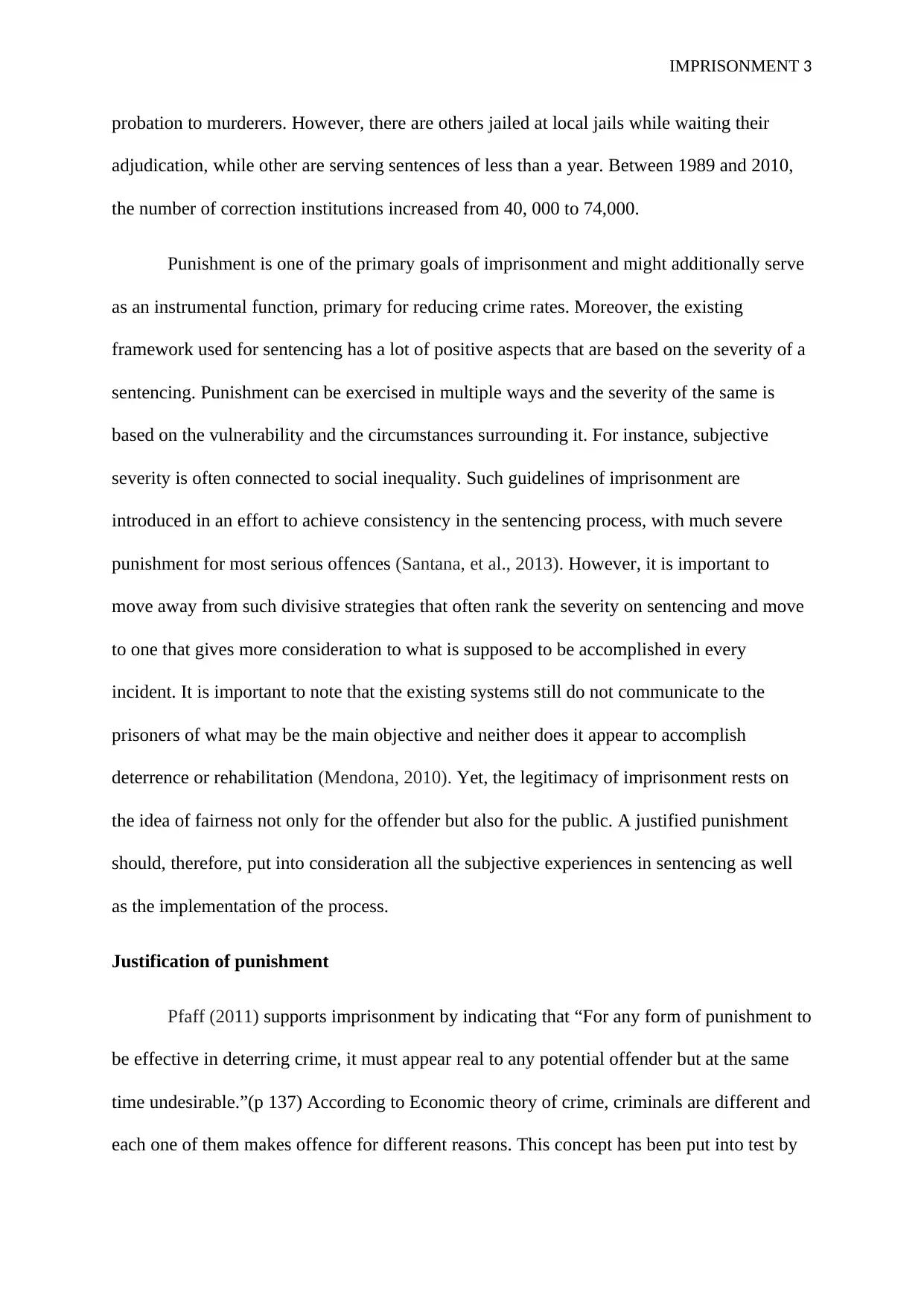
IMPRISONMENT 3
probation to murderers. However, there are others jailed at local jails while waiting their
adjudication, while other are serving sentences of less than a year. Between 1989 and 2010,
the number of correction institutions increased from 40, 000 to 74,000.
Punishment is one of the primary goals of imprisonment and might additionally serve
as an instrumental function, primary for reducing crime rates. Moreover, the existing
framework used for sentencing has a lot of positive aspects that are based on the severity of a
sentencing. Punishment can be exercised in multiple ways and the severity of the same is
based on the vulnerability and the circumstances surrounding it. For instance, subjective
severity is often connected to social inequality. Such guidelines of imprisonment are
introduced in an effort to achieve consistency in the sentencing process, with much severe
punishment for most serious offences (Santana, et al., 2013). However, it is important to
move away from such divisive strategies that often rank the severity on sentencing and move
to one that gives more consideration to what is supposed to be accomplished in every
incident. It is important to note that the existing systems still do not communicate to the
prisoners of what may be the main objective and neither does it appear to accomplish
deterrence or rehabilitation (Mendona, 2010). Yet, the legitimacy of imprisonment rests on
the idea of fairness not only for the offender but also for the public. A justified punishment
should, therefore, put into consideration all the subjective experiences in sentencing as well
as the implementation of the process.
Justification of punishment
Pfaff (2011) supports imprisonment by indicating that “For any form of punishment to
be effective in deterring crime, it must appear real to any potential offender but at the same
time undesirable.”(p 137) According to Economic theory of crime, criminals are different and
each one of them makes offence for different reasons. This concept has been put into test by
probation to murderers. However, there are others jailed at local jails while waiting their
adjudication, while other are serving sentences of less than a year. Between 1989 and 2010,
the number of correction institutions increased from 40, 000 to 74,000.
Punishment is one of the primary goals of imprisonment and might additionally serve
as an instrumental function, primary for reducing crime rates. Moreover, the existing
framework used for sentencing has a lot of positive aspects that are based on the severity of a
sentencing. Punishment can be exercised in multiple ways and the severity of the same is
based on the vulnerability and the circumstances surrounding it. For instance, subjective
severity is often connected to social inequality. Such guidelines of imprisonment are
introduced in an effort to achieve consistency in the sentencing process, with much severe
punishment for most serious offences (Santana, et al., 2013). However, it is important to
move away from such divisive strategies that often rank the severity on sentencing and move
to one that gives more consideration to what is supposed to be accomplished in every
incident. It is important to note that the existing systems still do not communicate to the
prisoners of what may be the main objective and neither does it appear to accomplish
deterrence or rehabilitation (Mendona, 2010). Yet, the legitimacy of imprisonment rests on
the idea of fairness not only for the offender but also for the public. A justified punishment
should, therefore, put into consideration all the subjective experiences in sentencing as well
as the implementation of the process.
Justification of punishment
Pfaff (2011) supports imprisonment by indicating that “For any form of punishment to
be effective in deterring crime, it must appear real to any potential offender but at the same
time undesirable.”(p 137) According to Economic theory of crime, criminals are different and
each one of them makes offence for different reasons. This concept has been put into test by
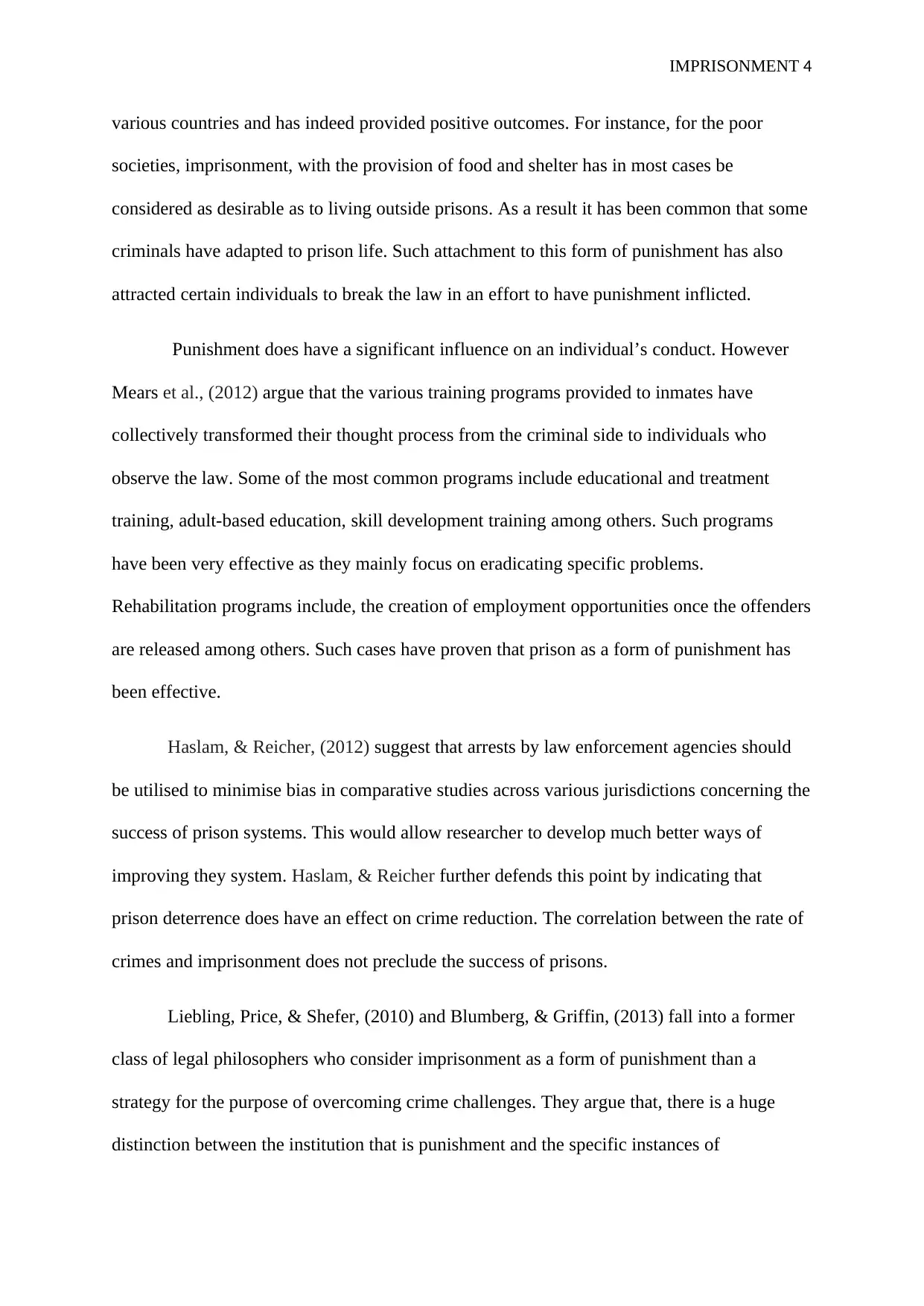
IMPRISONMENT 4
various countries and has indeed provided positive outcomes. For instance, for the poor
societies, imprisonment, with the provision of food and shelter has in most cases be
considered as desirable as to living outside prisons. As a result it has been common that some
criminals have adapted to prison life. Such attachment to this form of punishment has also
attracted certain individuals to break the law in an effort to have punishment inflicted.
Punishment does have a significant influence on an individual’s conduct. However
Mears et al., (2012) argue that the various training programs provided to inmates have
collectively transformed their thought process from the criminal side to individuals who
observe the law. Some of the most common programs include educational and treatment
training, adult-based education, skill development training among others. Such programs
have been very effective as they mainly focus on eradicating specific problems.
Rehabilitation programs include, the creation of employment opportunities once the offenders
are released among others. Such cases have proven that prison as a form of punishment has
been effective.
Haslam, & Reicher, (2012) suggest that arrests by law enforcement agencies should
be utilised to minimise bias in comparative studies across various jurisdictions concerning the
success of prison systems. This would allow researcher to develop much better ways of
improving they system. Haslam, & Reicher further defends this point by indicating that
prison deterrence does have an effect on crime reduction. The correlation between the rate of
crimes and imprisonment does not preclude the success of prisons.
Liebling, Price, & Shefer, (2010) and Blumberg, & Griffin, (2013) fall into a former
class of legal philosophers who consider imprisonment as a form of punishment than a
strategy for the purpose of overcoming crime challenges. They argue that, there is a huge
distinction between the institution that is punishment and the specific instances of
various countries and has indeed provided positive outcomes. For instance, for the poor
societies, imprisonment, with the provision of food and shelter has in most cases be
considered as desirable as to living outside prisons. As a result it has been common that some
criminals have adapted to prison life. Such attachment to this form of punishment has also
attracted certain individuals to break the law in an effort to have punishment inflicted.
Punishment does have a significant influence on an individual’s conduct. However
Mears et al., (2012) argue that the various training programs provided to inmates have
collectively transformed their thought process from the criminal side to individuals who
observe the law. Some of the most common programs include educational and treatment
training, adult-based education, skill development training among others. Such programs
have been very effective as they mainly focus on eradicating specific problems.
Rehabilitation programs include, the creation of employment opportunities once the offenders
are released among others. Such cases have proven that prison as a form of punishment has
been effective.
Haslam, & Reicher, (2012) suggest that arrests by law enforcement agencies should
be utilised to minimise bias in comparative studies across various jurisdictions concerning the
success of prison systems. This would allow researcher to develop much better ways of
improving they system. Haslam, & Reicher further defends this point by indicating that
prison deterrence does have an effect on crime reduction. The correlation between the rate of
crimes and imprisonment does not preclude the success of prisons.
Liebling, Price, & Shefer, (2010) and Blumberg, & Griffin, (2013) fall into a former
class of legal philosophers who consider imprisonment as a form of punishment than a
strategy for the purpose of overcoming crime challenges. They argue that, there is a huge
distinction between the institution that is punishment and the specific instances of
Secure Best Marks with AI Grader
Need help grading? Try our AI Grader for instant feedback on your assignments.
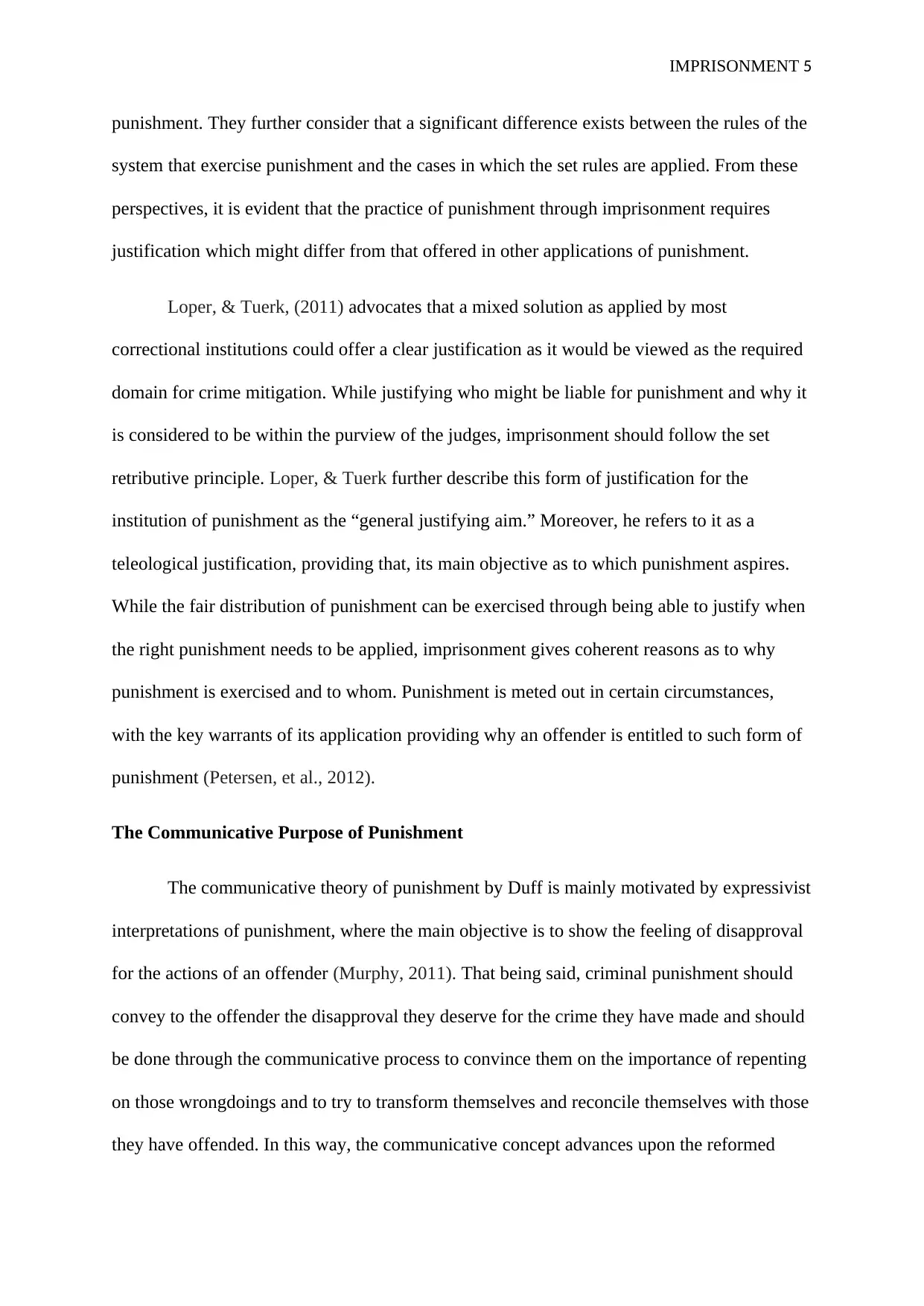
IMPRISONMENT 5
punishment. They further consider that a significant difference exists between the rules of the
system that exercise punishment and the cases in which the set rules are applied. From these
perspectives, it is evident that the practice of punishment through imprisonment requires
justification which might differ from that offered in other applications of punishment.
Loper, & Tuerk, (2011) advocates that a mixed solution as applied by most
correctional institutions could offer a clear justification as it would be viewed as the required
domain for crime mitigation. While justifying who might be liable for punishment and why it
is considered to be within the purview of the judges, imprisonment should follow the set
retributive principle. Loper, & Tuerk further describe this form of justification for the
institution of punishment as the “general justifying aim.” Moreover, he refers to it as a
teleological justification, providing that, its main objective as to which punishment aspires.
While the fair distribution of punishment can be exercised through being able to justify when
the right punishment needs to be applied, imprisonment gives coherent reasons as to why
punishment is exercised and to whom. Punishment is meted out in certain circumstances,
with the key warrants of its application providing why an offender is entitled to such form of
punishment (Petersen, et al., 2012).
The Communicative Purpose of Punishment
The communicative theory of punishment by Duff is mainly motivated by expressivist
interpretations of punishment, where the main objective is to show the feeling of disapproval
for the actions of an offender (Murphy, 2011). That being said, criminal punishment should
convey to the offender the disapproval they deserve for the crime they have made and should
be done through the communicative process to convince them on the importance of repenting
on those wrongdoings and to try to transform themselves and reconcile themselves with those
they have offended. In this way, the communicative concept advances upon the reformed
punishment. They further consider that a significant difference exists between the rules of the
system that exercise punishment and the cases in which the set rules are applied. From these
perspectives, it is evident that the practice of punishment through imprisonment requires
justification which might differ from that offered in other applications of punishment.
Loper, & Tuerk, (2011) advocates that a mixed solution as applied by most
correctional institutions could offer a clear justification as it would be viewed as the required
domain for crime mitigation. While justifying who might be liable for punishment and why it
is considered to be within the purview of the judges, imprisonment should follow the set
retributive principle. Loper, & Tuerk further describe this form of justification for the
institution of punishment as the “general justifying aim.” Moreover, he refers to it as a
teleological justification, providing that, its main objective as to which punishment aspires.
While the fair distribution of punishment can be exercised through being able to justify when
the right punishment needs to be applied, imprisonment gives coherent reasons as to why
punishment is exercised and to whom. Punishment is meted out in certain circumstances,
with the key warrants of its application providing why an offender is entitled to such form of
punishment (Petersen, et al., 2012).
The Communicative Purpose of Punishment
The communicative theory of punishment by Duff is mainly motivated by expressivist
interpretations of punishment, where the main objective is to show the feeling of disapproval
for the actions of an offender (Murphy, 2011). That being said, criminal punishment should
convey to the offender the disapproval they deserve for the crime they have made and should
be done through the communicative process to convince them on the importance of repenting
on those wrongdoings and to try to transform themselves and reconcile themselves with those
they have offended. In this way, the communicative concept advances upon the reformed

IMPRISONMENT 6
conducts of the offenders by treating them as responsible individuals who can drastically
comprehend the offences they have done and to apologize (Schinkel, 2014).
Based on this concept, punishment is a proper technique of communication to
offenders about their criminal behaviors. However, punishment alone cannot be part of the
communicative initiative. The trials and sentencing also play a fundamental role (Williams,
2011). As such, it makes a lot of sense for Duff to recommend the imprisonment as a forms
of punishment as it would serve as communicative of the moral message to the offenders. The
direct communicative model has been considered by many prison systems to be valuable
(Stojkovic, 2009). There are multiple objectives attached to it along with a number of
Behavioral dimensions that assist in monitoring behavioural improvement of an inmate.
Other communicative options or alternative to this procedure are usually mixed.
Imprisonment as a Shock to Repentance
This strategy might not pose a lot of challenges if incarceration itself is
communicative. If a conviction could also be communicative, then it cannot be a
manipulative threat to induce recidivism. It would serve as a proper way of enhancing
communicative repentance. As such Morris et al., (2012) believes that Incarceration can
indeed function as an essential tool in an appropriate communicative punitive system by
efficiently delivering a moral message of misconduct to an offender. Nevertheless, there is a
number of problems with this strategy. First, it might end up proving too much about the
repentance of the offender. Instead, it should only serve as an appropriate stimulus to
repentance and not as a gauge to responsibility. Second, the harsh sanctions under this
strategy might shock the offenders into a more irrational and moral frame mind. As a result, it
might not qualify as a standard justification of imprisonment.
conducts of the offenders by treating them as responsible individuals who can drastically
comprehend the offences they have done and to apologize (Schinkel, 2014).
Based on this concept, punishment is a proper technique of communication to
offenders about their criminal behaviors. However, punishment alone cannot be part of the
communicative initiative. The trials and sentencing also play a fundamental role (Williams,
2011). As such, it makes a lot of sense for Duff to recommend the imprisonment as a forms
of punishment as it would serve as communicative of the moral message to the offenders. The
direct communicative model has been considered by many prison systems to be valuable
(Stojkovic, 2009). There are multiple objectives attached to it along with a number of
Behavioral dimensions that assist in monitoring behavioural improvement of an inmate.
Other communicative options or alternative to this procedure are usually mixed.
Imprisonment as a Shock to Repentance
This strategy might not pose a lot of challenges if incarceration itself is
communicative. If a conviction could also be communicative, then it cannot be a
manipulative threat to induce recidivism. It would serve as a proper way of enhancing
communicative repentance. As such Morris et al., (2012) believes that Incarceration can
indeed function as an essential tool in an appropriate communicative punitive system by
efficiently delivering a moral message of misconduct to an offender. Nevertheless, there is a
number of problems with this strategy. First, it might end up proving too much about the
repentance of the offender. Instead, it should only serve as an appropriate stimulus to
repentance and not as a gauge to responsibility. Second, the harsh sanctions under this
strategy might shock the offenders into a more irrational and moral frame mind. As a result, it
might not qualify as a standard justification of imprisonment.
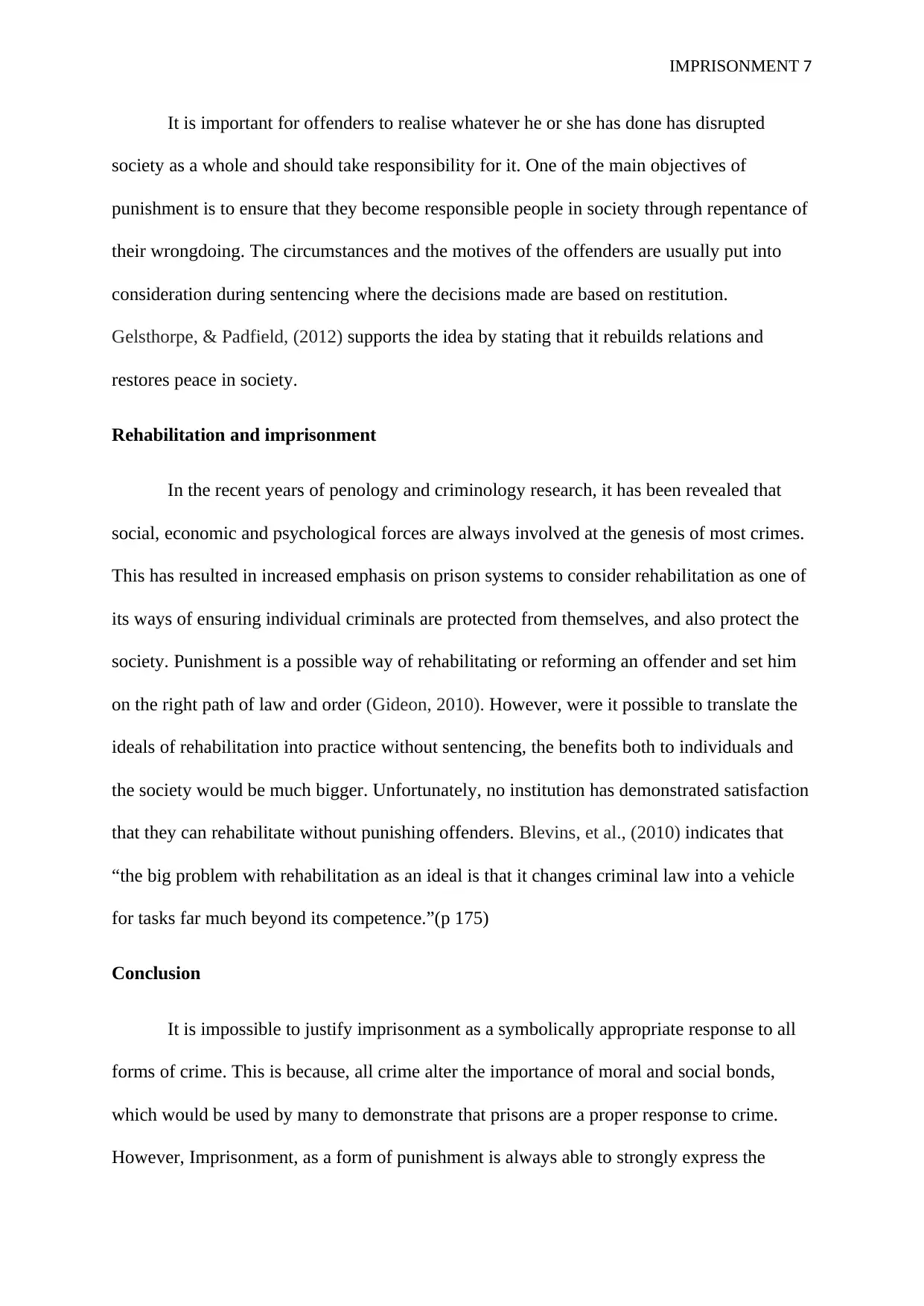
IMPRISONMENT 7
It is important for offenders to realise whatever he or she has done has disrupted
society as a whole and should take responsibility for it. One of the main objectives of
punishment is to ensure that they become responsible people in society through repentance of
their wrongdoing. The circumstances and the motives of the offenders are usually put into
consideration during sentencing where the decisions made are based on restitution.
Gelsthorpe, & Padfield, (2012) supports the idea by stating that it rebuilds relations and
restores peace in society.
Rehabilitation and imprisonment
In the recent years of penology and criminology research, it has been revealed that
social, economic and psychological forces are always involved at the genesis of most crimes.
This has resulted in increased emphasis on prison systems to consider rehabilitation as one of
its ways of ensuring individual criminals are protected from themselves, and also protect the
society. Punishment is a possible way of rehabilitating or reforming an offender and set him
on the right path of law and order (Gideon, 2010). However, were it possible to translate the
ideals of rehabilitation into practice without sentencing, the benefits both to individuals and
the society would be much bigger. Unfortunately, no institution has demonstrated satisfaction
that they can rehabilitate without punishing offenders. Blevins, et al., (2010) indicates that
“the big problem with rehabilitation as an ideal is that it changes criminal law into a vehicle
for tasks far much beyond its competence.”(p 175)
Conclusion
It is impossible to justify imprisonment as a symbolically appropriate response to all
forms of crime. This is because, all crime alter the importance of moral and social bonds,
which would be used by many to demonstrate that prisons are a proper response to crime.
However, Imprisonment, as a form of punishment is always able to strongly express the
It is important for offenders to realise whatever he or she has done has disrupted
society as a whole and should take responsibility for it. One of the main objectives of
punishment is to ensure that they become responsible people in society through repentance of
their wrongdoing. The circumstances and the motives of the offenders are usually put into
consideration during sentencing where the decisions made are based on restitution.
Gelsthorpe, & Padfield, (2012) supports the idea by stating that it rebuilds relations and
restores peace in society.
Rehabilitation and imprisonment
In the recent years of penology and criminology research, it has been revealed that
social, economic and psychological forces are always involved at the genesis of most crimes.
This has resulted in increased emphasis on prison systems to consider rehabilitation as one of
its ways of ensuring individual criminals are protected from themselves, and also protect the
society. Punishment is a possible way of rehabilitating or reforming an offender and set him
on the right path of law and order (Gideon, 2010). However, were it possible to translate the
ideals of rehabilitation into practice without sentencing, the benefits both to individuals and
the society would be much bigger. Unfortunately, no institution has demonstrated satisfaction
that they can rehabilitate without punishing offenders. Blevins, et al., (2010) indicates that
“the big problem with rehabilitation as an ideal is that it changes criminal law into a vehicle
for tasks far much beyond its competence.”(p 175)
Conclusion
It is impossible to justify imprisonment as a symbolically appropriate response to all
forms of crime. This is because, all crime alter the importance of moral and social bonds,
which would be used by many to demonstrate that prisons are a proper response to crime.
However, Imprisonment, as a form of punishment is always able to strongly express the
Paraphrase This Document
Need a fresh take? Get an instant paraphrase of this document with our AI Paraphraser
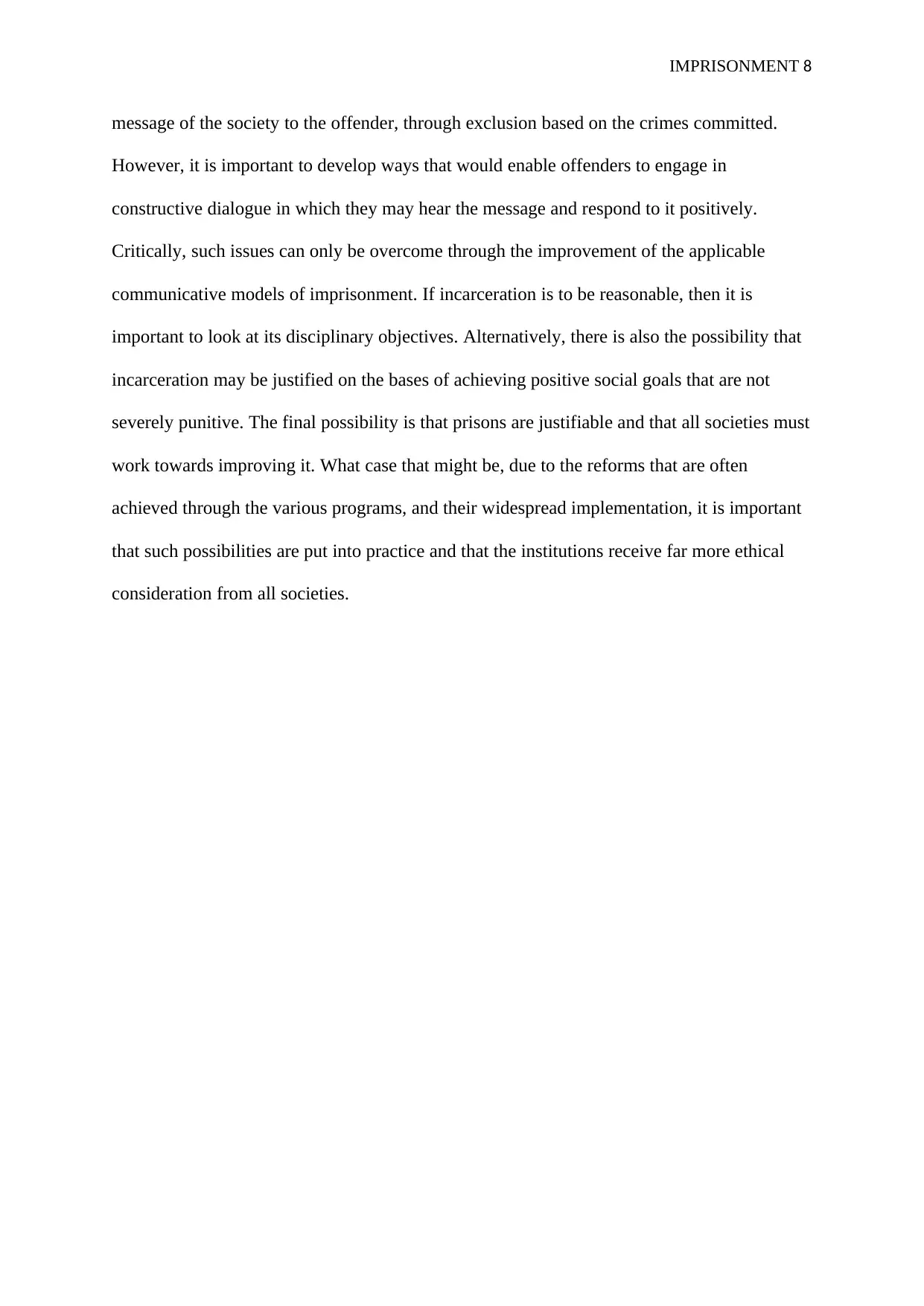
IMPRISONMENT 8
message of the society to the offender, through exclusion based on the crimes committed.
However, it is important to develop ways that would enable offenders to engage in
constructive dialogue in which they may hear the message and respond to it positively.
Critically, such issues can only be overcome through the improvement of the applicable
communicative models of imprisonment. If incarceration is to be reasonable, then it is
important to look at its disciplinary objectives. Alternatively, there is also the possibility that
incarceration may be justified on the bases of achieving positive social goals that are not
severely punitive. The final possibility is that prisons are justifiable and that all societies must
work towards improving it. What case that might be, due to the reforms that are often
achieved through the various programs, and their widespread implementation, it is important
that such possibilities are put into practice and that the institutions receive far more ethical
consideration from all societies.
message of the society to the offender, through exclusion based on the crimes committed.
However, it is important to develop ways that would enable offenders to engage in
constructive dialogue in which they may hear the message and respond to it positively.
Critically, such issues can only be overcome through the improvement of the applicable
communicative models of imprisonment. If incarceration is to be reasonable, then it is
important to look at its disciplinary objectives. Alternatively, there is also the possibility that
incarceration may be justified on the bases of achieving positive social goals that are not
severely punitive. The final possibility is that prisons are justifiable and that all societies must
work towards improving it. What case that might be, due to the reforms that are often
achieved through the various programs, and their widespread implementation, it is important
that such possibilities are put into practice and that the institutions receive far more ethical
consideration from all societies.
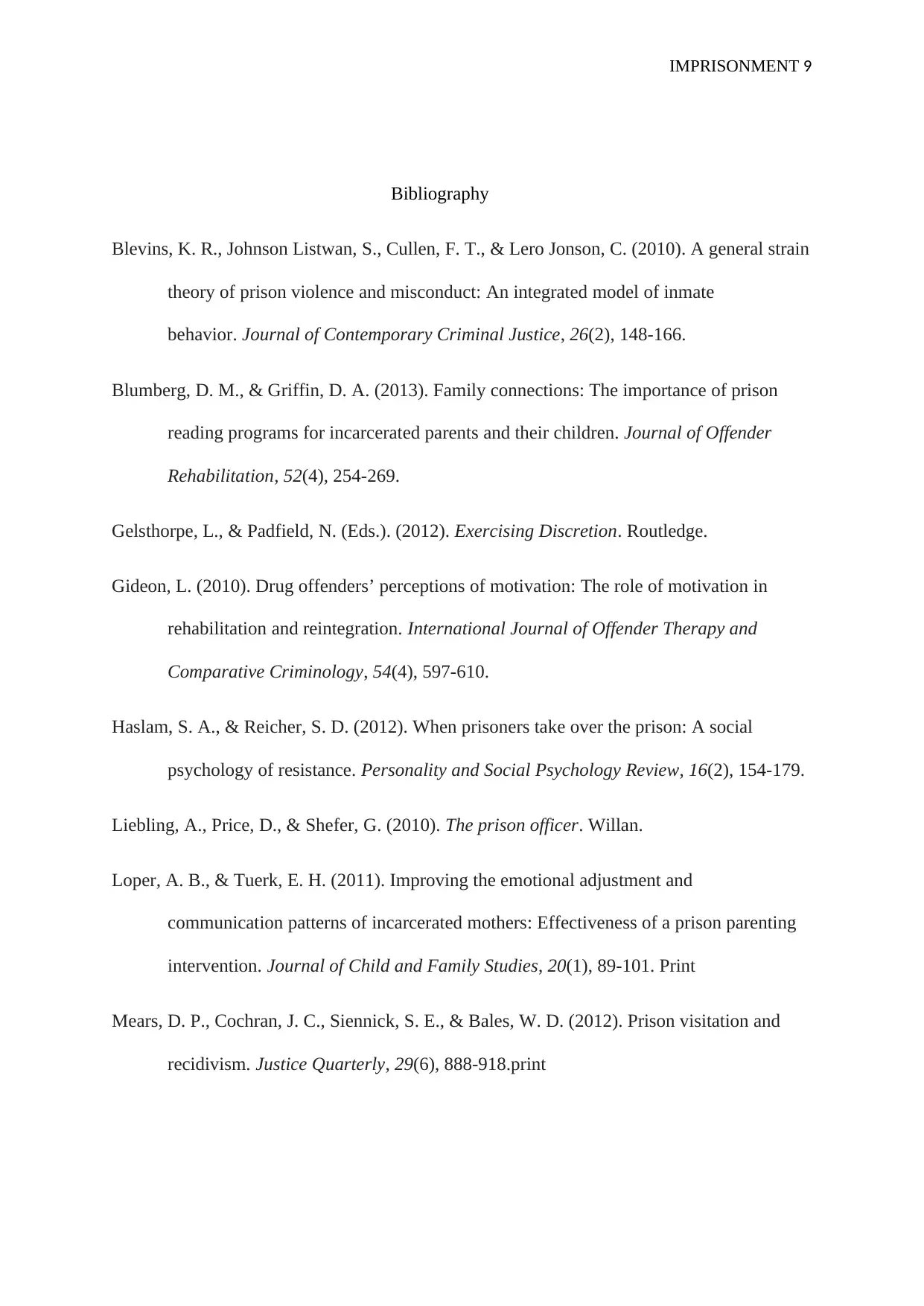
IMPRISONMENT 9
Bibliography
Blevins, K. R., Johnson Listwan, S., Cullen, F. T., & Lero Jonson, C. (2010). A general strain
theory of prison violence and misconduct: An integrated model of inmate
behavior. Journal of Contemporary Criminal Justice, 26(2), 148-166.
Blumberg, D. M., & Griffin, D. A. (2013). Family connections: The importance of prison
reading programs for incarcerated parents and their children. Journal of Offender
Rehabilitation, 52(4), 254-269.
Gelsthorpe, L., & Padfield, N. (Eds.). (2012). Exercising Discretion. Routledge.
Gideon, L. (2010). Drug offenders’ perceptions of motivation: The role of motivation in
rehabilitation and reintegration. International Journal of Offender Therapy and
Comparative Criminology, 54(4), 597-610.
Haslam, S. A., & Reicher, S. D. (2012). When prisoners take over the prison: A social
psychology of resistance. Personality and Social Psychology Review, 16(2), 154-179.
Liebling, A., Price, D., & Shefer, G. (2010). The prison officer. Willan.
Loper, A. B., & Tuerk, E. H. (2011). Improving the emotional adjustment and
communication patterns of incarcerated mothers: Effectiveness of a prison parenting
intervention. Journal of Child and Family Studies, 20(1), 89-101. Print
Mears, D. P., Cochran, J. C., Siennick, S. E., & Bales, W. D. (2012). Prison visitation and
recidivism. Justice Quarterly, 29(6), 888-918.print
Bibliography
Blevins, K. R., Johnson Listwan, S., Cullen, F. T., & Lero Jonson, C. (2010). A general strain
theory of prison violence and misconduct: An integrated model of inmate
behavior. Journal of Contemporary Criminal Justice, 26(2), 148-166.
Blumberg, D. M., & Griffin, D. A. (2013). Family connections: The importance of prison
reading programs for incarcerated parents and their children. Journal of Offender
Rehabilitation, 52(4), 254-269.
Gelsthorpe, L., & Padfield, N. (Eds.). (2012). Exercising Discretion. Routledge.
Gideon, L. (2010). Drug offenders’ perceptions of motivation: The role of motivation in
rehabilitation and reintegration. International Journal of Offender Therapy and
Comparative Criminology, 54(4), 597-610.
Haslam, S. A., & Reicher, S. D. (2012). When prisoners take over the prison: A social
psychology of resistance. Personality and Social Psychology Review, 16(2), 154-179.
Liebling, A., Price, D., & Shefer, G. (2010). The prison officer. Willan.
Loper, A. B., & Tuerk, E. H. (2011). Improving the emotional adjustment and
communication patterns of incarcerated mothers: Effectiveness of a prison parenting
intervention. Journal of Child and Family Studies, 20(1), 89-101. Print
Mears, D. P., Cochran, J. C., Siennick, S. E., & Bales, W. D. (2012). Prison visitation and
recidivism. Justice Quarterly, 29(6), 888-918.print
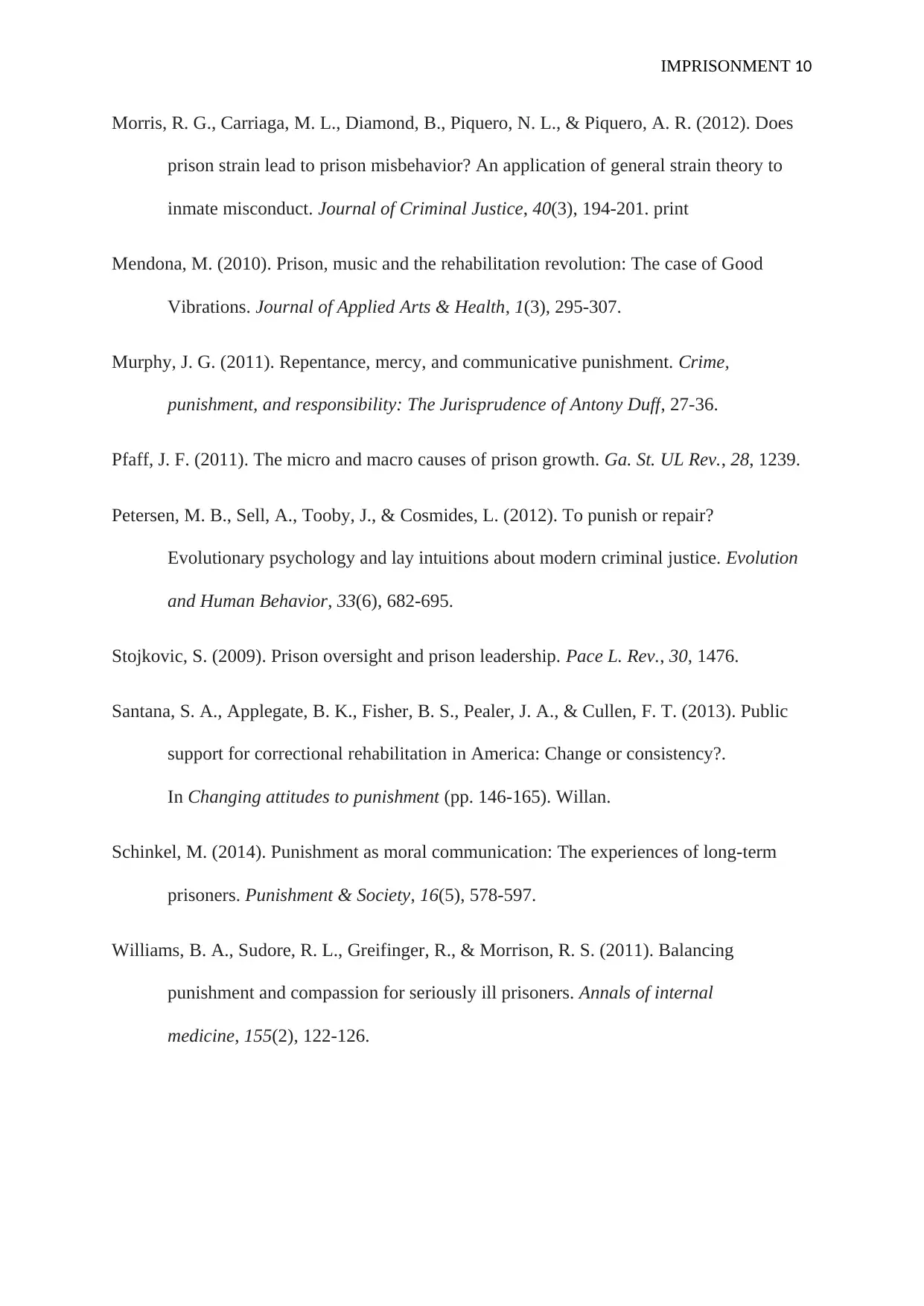
IMPRISONMENT 10
Morris, R. G., Carriaga, M. L., Diamond, B., Piquero, N. L., & Piquero, A. R. (2012). Does
prison strain lead to prison misbehavior? An application of general strain theory to
inmate misconduct. Journal of Criminal Justice, 40(3), 194-201. print
Mendona, M. (2010). Prison, music and the rehabilitation revolution: The case of Good
Vibrations. Journal of Applied Arts & Health, 1(3), 295-307.
Murphy, J. G. (2011). Repentance, mercy, and communicative punishment. Crime,
punishment, and responsibility: The Jurisprudence of Antony Duff, 27-36.
Pfaff, J. F. (2011). The micro and macro causes of prison growth. Ga. St. UL Rev., 28, 1239.
Petersen, M. B., Sell, A., Tooby, J., & Cosmides, L. (2012). To punish or repair?
Evolutionary psychology and lay intuitions about modern criminal justice. Evolution
and Human Behavior, 33(6), 682-695.
Stojkovic, S. (2009). Prison oversight and prison leadership. Pace L. Rev., 30, 1476.
Santana, S. A., Applegate, B. K., Fisher, B. S., Pealer, J. A., & Cullen, F. T. (2013). Public
support for correctional rehabilitation in America: Change or consistency?.
In Changing attitudes to punishment (pp. 146-165). Willan.
Schinkel, M. (2014). Punishment as moral communication: The experiences of long-term
prisoners. Punishment & Society, 16(5), 578-597.
Williams, B. A., Sudore, R. L., Greifinger, R., & Morrison, R. S. (2011). Balancing
punishment and compassion for seriously ill prisoners. Annals of internal
medicine, 155(2), 122-126.
Morris, R. G., Carriaga, M. L., Diamond, B., Piquero, N. L., & Piquero, A. R. (2012). Does
prison strain lead to prison misbehavior? An application of general strain theory to
inmate misconduct. Journal of Criminal Justice, 40(3), 194-201. print
Mendona, M. (2010). Prison, music and the rehabilitation revolution: The case of Good
Vibrations. Journal of Applied Arts & Health, 1(3), 295-307.
Murphy, J. G. (2011). Repentance, mercy, and communicative punishment. Crime,
punishment, and responsibility: The Jurisprudence of Antony Duff, 27-36.
Pfaff, J. F. (2011). The micro and macro causes of prison growth. Ga. St. UL Rev., 28, 1239.
Petersen, M. B., Sell, A., Tooby, J., & Cosmides, L. (2012). To punish or repair?
Evolutionary psychology and lay intuitions about modern criminal justice. Evolution
and Human Behavior, 33(6), 682-695.
Stojkovic, S. (2009). Prison oversight and prison leadership. Pace L. Rev., 30, 1476.
Santana, S. A., Applegate, B. K., Fisher, B. S., Pealer, J. A., & Cullen, F. T. (2013). Public
support for correctional rehabilitation in America: Change or consistency?.
In Changing attitudes to punishment (pp. 146-165). Willan.
Schinkel, M. (2014). Punishment as moral communication: The experiences of long-term
prisoners. Punishment & Society, 16(5), 578-597.
Williams, B. A., Sudore, R. L., Greifinger, R., & Morrison, R. S. (2011). Balancing
punishment and compassion for seriously ill prisoners. Annals of internal
medicine, 155(2), 122-126.
1 out of 10
Related Documents
Your All-in-One AI-Powered Toolkit for Academic Success.
+13062052269
info@desklib.com
Available 24*7 on WhatsApp / Email
![[object Object]](/_next/static/media/star-bottom.7253800d.svg)
Unlock your academic potential
© 2024 | Zucol Services PVT LTD | All rights reserved.





